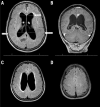Normal-pressure hydrocephalus: A critical review
- PMID: 31285787
- PMCID: PMC6601311
- DOI: 10.1590/1980-57642018dn13-020001
Normal-pressure hydrocephalus: A critical review
Erratum in
-
Errata.Dement Neuropsychol. 2019 Jul-Sep;13(3):361. doi: 10.1590/1980-57642018dn13-030016. Dement Neuropsychol. 2019. PMID: 31555412 Free PMC article.
Abstract
Normal-pressure hydrocephalus (NPH) is a potentially reversible syndrome characterized by enlarged cerebral ventricles (ventriculomegaly), cognitive impairment, gait apraxia and urinary incontinence. A critical review of the concept, pathophysiology, diagnosis, and treatment of both idiopathic and secondary NPH was conducted. We searched Medline and PubMed databases from January 2012 to December 2018 using the keywords "normal-pressure hydrocephalus" / "idiopathic normal-pressure hydrocephalus" / "secondary normal-pressure hydrocephalus" / "NPH" / "ventriculoperitoneal shunt". The initial search produced 341 hits. After careful selection, a total of 54 articles were chosen and additional relevant studies were included during the process of writing this article. NPH is an important cause of potentially reversible dementia, frequent falls and recurrent urinary infections in the elderly. The clinical and imaging features of NPH may be incomplete or nonspecific, posing a diagnostic challenge for medical doctors and often requiring expert assessment to minimize unsuccessful surgical treatments. Recent advances resulting from the use of non-invasive MRI methods for quantifying cerebral blood flow, in particular arterial spin-labeling (ASL), and the frequent association of NPH and obstructive sleep apnea (OSA), offer new avenues to understand and treat NPH.
A hidrocefalia de pressão normal (HPN) é uma síndrome potencialmente reversível marcada por ventrículos cerebrais alargados (ventriculomegalia), declínio cognitivo, apraxia da marcha e incontinência urinária. Revisar criticamente o conceito, a fisiopatologia, o diagnóstico e o tratamento da HPN idiopática e secundária. Os autores acessaram as bases de dados Medline e Pubmed entre janeiro de 2012 e dezembro de 2018, utilizando as palavras-chave “normal-pressure hydrocephalus” / “idiopathic normal-pressure hydrocephalus” / “secondary normal-pressure hydrocephalus” / “NPH” / “ventriculoperitoneal shunt”. A busca inicial resultou em 341 artigos. Após cuidadosa seleção, 54 estudos foram escolhidos e pesquisas adicionais foram incluídas durante o processo de elaboração do manuscrito. A HPN é uma importante causa de demência potencialmente reversível, quedas frequentes e infecção urinária recorrente em idosos. As características clínicas e de imagem da HPN podem ser incompletas ou inespecíficas, de modo que este se torna um diagnóstico difícil para médicos. Não raro uma avaliação por especialista é necessária, visando minimizar tratamentos cirúrgicos ineficazes. Avanços recentes advindos do uso não invasivo de ressonância magnética para quantificação do fluxo sanguíneo cerebral, em particular arterial spin-labeling (ASL), assim como a usual associação entre HPN e apneia obstrutiva do sono representam novos meios de entender e de tratar a HPN.
Keywords: cerebral blood flow; falls; incontinence; normal-pressure hydrocephalus; reversible dementia; spinal tap test.
Conflict of interest statement
Disclosure: The authors report no conflicts of interest.
Figures


Similar articles
-
Pathologically Verified Corticobasal Degeneration Mimicking Richardson's Syndrome Coexisting with Clinically and Radiologically Shunt-Responsive Normal Pressure Hydrocephalus.Mov Disord Clin Pract. 2022 Apr 12;9(4):508-515. doi: 10.1002/mdc3.13442. eCollection 2022 May. Mov Disord Clin Pract. 2022. PMID: 35582317 Free PMC article.
-
Prevalence of Fecal Incontinence in Normal Pressure Hydrocephalus: A Prospective Evaluation of 100 Patients.World Neurosurg. 2023 Oct;178:e1-e5. doi: 10.1016/j.wneu.2023.07.120. Epub 2023 Jul 31. World Neurosurg. 2023. PMID: 37532018
-
Segmentation and labeling of the ventricular system in normal pressure hydrocephalus using patch-based tissue classification and multi-atlas labeling.Proc SPIE Int Soc Opt Eng. 2016 Mar 21;9784:97840G. doi: 10.1117/12.2216511. Epub 2016 Feb 27. Proc SPIE Int Soc Opt Eng. 2016. PMID: 27199501 Free PMC article.
-
Normal pressure hydrocephalus: Neurophysiological and neuropsychological aspects: a narrative review.Medicine (Baltimore). 2022 Mar 4;101(9):e28922. doi: 10.1097/MD.0000000000028922. Medicine (Baltimore). 2022. PMID: 35244047 Free PMC article. Review.
-
[Diagnosis of normal pressure hydrocephalus in elderly patients: a review].Geriatr Psychol Neuropsychiatr Vieil. 2012 Dec;10(4):415-25. doi: 10.1684/pnv.2012.0373. Geriatr Psychol Neuropsychiatr Vieil. 2012. PMID: 23250022 Review. French.
Cited by
-
Alzheimer's Disease CSF Biomarkers as Possible Indicators of Tap-Test Response in Idiopathic Normal Pressure Hydrocephalus.Brain Sci. 2023 Nov 15;13(11):1593. doi: 10.3390/brainsci13111593. Brain Sci. 2023. PMID: 38002553 Free PMC article.
-
Predictive value of spinal CSF volume in the preoperative assessment of patients with idiopathic normal-pressure hydrocephalus.Front Neurol. 2023 Oct 5;14:1234396. doi: 10.3389/fneur.2023.1234396. eCollection 2023. Front Neurol. 2023. PMID: 37869132 Free PMC article.
-
Dynamic functional networks in idiopathic normal pressure hydrocephalus: Alterations and reversibility by CSF tap test.Hum Brain Mapp. 2021 Apr 1;42(5):1485-1502. doi: 10.1002/hbm.25308. Epub 2020 Dec 9. Hum Brain Mapp. 2021. PMID: 33296129 Free PMC article.
-
Diffuse glioma manifesting as normal pressure hydrocephalus: A potential pitfall in diagnosis-a case report.Cereb Circ Cogn Behav. 2021 Mar 18;2:100009. doi: 10.1016/j.cccb.2021.100009. eCollection 2021. Cereb Circ Cogn Behav. 2021. PMID: 36324724 Free PMC article.
-
Callosal Angle Sub-Score of the Radscale in Patients with Idiopathic Normal Pressure Hydrocephalus Is Associated with Positive Tap Test Response.J Clin Med. 2022 May 20;11(10):2898. doi: 10.3390/jcm11102898. J Clin Med. 2022. PMID: 35629023 Free PMC article.
References
-
- Missori P, Paolini S, Currà A. From congenital to idiopathic adult hydrocephalus A historical research. Brain. 2010;133:1836–1849. - PubMed
-
- Hakim S, Adams RD. The special clinical problem of symptomatic hydrocephalus with normal cerebrospinal fluid pressure Observations on cerebrospinal fluid hydrodynamics. J Neurol Sci. 1965;2:307–327. - PubMed
-
- Adams RD, Fisher CM, Hakim S, Ojemann RG, Sweet WH. Symptomatic occult hydrocephalus with "normal" cerebrospinal-fluid pressure A treatable syndrome. N Engl J Med. 1965;273:117–126. - PubMed
-
- Wallenstein MB, McKhann GM., 2nd Salomón Hakim and the discovery of normal-pressure hydrocephalus. Neurosurgery. 2010;67(1):155–159. - PubMed
-
- Shenkin HA, Greenberg J, Bouzarth WF, Gutterman P, Morales JO. Ventricular shunting for relief of senile symptoms. JAMA. 1973;225:1486–1489. - PubMed
Publication types
LinkOut - more resources
Full Text Sources
Miscellaneous

